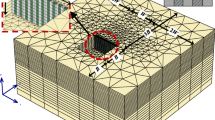Abstract
In urban areas, there are many situations where basement of new constructions or underground utilities are proposed to be constructed adjacent to old buildings. Of greatest concern are buildings with shallow foundations that do not extend below the zone of influence of the adjacent excavation. For deep excavation, the presence of a cantilever stage at the beginning of a construction sequence can often lead to excessive movements. Therefore over-excavation can also be a primary cause of excessive movements. In the present study, shallow excavation was considered. Three Dimensional Finite Element (3D FE) study was carried out in the present study. A cantilever contiguous pile wall was selected because it is common and relatively economic to be used in cohesive soil. Parametric study were performed considering excavation depth, pile embedded depth, and wall stiffness. Some design recommendations were given to provide a safe supporting system in clay.













Similar content being viewed by others
References
Addenbrooke TI (1994) A flexibility number for the displacement controlled design of multi propped retaining walls. Ground Eng 27(7):41–45
Bryson LS, Zapata-Medina DG (2012) Method for estimating system stiffness for excavation support walls. J Geotech Geoenviron Eng 138(9):1104–1115
Chen LT, Poulos HG (1997) Piles subjected to lateral soil movement. J Geotech Geoenviron Eng 123(9):802–811
Clough GW, Smith EM, Sweeney BP (1989) Movement control of excavation support by system by iterative design. Current principles and practices, Foundation Engineering Congress, 2, ASCE, New York, 869–884
Guo WD (2012) Theory and practice of pile foundations. CRC Press, Boca Raton
Long M (2001) Database for retaining wall and ground movements due to deep excavations. J Geotech Geoenviron Eng 127(3):203–224
Long M, Brangan C, Menkiti C, Looby M, Casey P (2012) Retaining walls in dublin boulder clay, Ireland. Inst Civil Eng J Geotech Eng 165(GE4):247–266
Ou C (2006) Deep excavation: theory and practice. Taylor & Francis/Balkema, London
Ou CY, Chiou DC, Wu TS (1996) Three-dimensional finite element analyses of deep excavations. J Geotech Eng, ASCE 122(5):337–345
Parry RHG (1995) Mohr circles, stress paths and geotechnics. E & FN Spon, London
PLAXIS 3D FOUNDATION, Version 1.6 (2006) PLAXIS finite element code for soil and rock analysis. Delft University of Technology & PLAXIS B.V, Delft
Poulos HG, Chen LT (1995) Model tests on single model piles subjected to lateral soil movement. Soils Found 35(4):85–92
Poulos HG, Chen LT (1996) Pile response due to unsupported excavation-induced lateral soil movement. Can Geotech J 33(4):670–677
Poulos HG, Chen LT (1997) Pile response due to excavation-induced lateral soil movement. J Geotech Geoenviron Eng 123(2):94–99
Poulos HG, Davis EH (1980) Pile foundation analysis and design. Wiley, New York
Stewart DP, Jewell RJ, Randolph MF (1994) Design of piled bridge abutment on soft clay for loading from lateral soil movements. Geotechnique 44(2):277–296
Terzaghi K (1943) Theoretical soil mechanics. John Wiley and Sons, New York
Ukritchon B, Whittle AJ, Sloan SW (2003) Undrained stability of braced excavations in clay. J Geotech Geoenviron Eng 129(8):738–755
Zapata-Medina, D.G. (2007) Semi-Empirical Method for Designing Excavation Support Systems Based on Deformation Control. M.Sc. Thesis. University of Kentucky. pp 468
Author information
Authors and Affiliations
Corresponding author
Rights and permissions
About this article
Cite this article
Ramadan, M.I., Ramadan, E.H. & Khashila, M.M. Cantilever Contiguous Pile Wall for Supporting Excavation in Clay. Geotech Geol Eng 36, 1545–1558 (2018). https://doi.org/10.1007/s10706-017-0407-5
Received:
Accepted:
Published:
Issue Date:
DOI: https://doi.org/10.1007/s10706-017-0407-5




